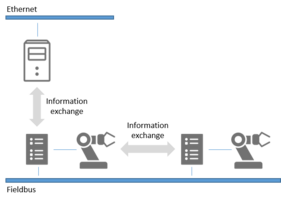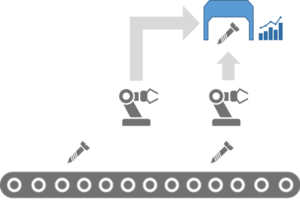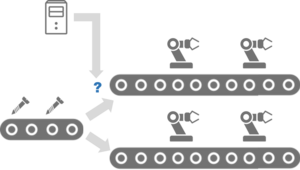Notice: This Wiki is now read only and edits are no longer possible. Please see: https://gitlab.eclipse.org/eclipsefdn/helpdesk/-/wikis/Wiki-shutdown-plan for the plan.
BaSyx / Benefits
Contents
BaSyx benefits and use-cases
BaSys 4.0 enables the digitalization of manufacturing processes and the implementation of Industrie 4.0. Eclipse BaSyx is an Open-Source reference implementation of BaSys 4.0 concepts that include common Industrie 4.0 components and a Software Development Kit (SDK) that supports the development of new components. Eclipse BaSyx did originate from the BaSys 4.0 project, which is funded by the german ministry of Research and Education. The following examples highlight common Industrie 4.0 use-cases that can be realized with the BaSyx middleware:
Digitalization of manufacturing process
BaSys 4.0 enables end-to-end digitalization of manufacturing processes. This enables end-to-end communication between devices in office-floor and in shop floor and therefore breaks the automation pyramid. BaSys 4.0 supports horizontal and vertical networking of production devices:
- Horizontal networking is the connection of devices along the production process. BaSys defines communication primitives, and interfaces that enables devices from different vendors and different device types to communicate with each other.
- Vertical networking is the connection of entities in different levels of the automation pyramid, e.g. a connection between an ERP system in office floor and a device in shop floor. Linking office- and shop floor enables for example a better control of production and the creation of dashboards that visualize the production status in one place. Operators do not have to move to machines to query their status and faults are detected much faster.
BaSys 4.0 uses Asset Administration Shells (AAS) and AAS sub models to structure information. End-to-end communication across network is supported by defined communication primitives and by BaSys gateways that bridge networks and protocols to yield one end-to-end communication medium, the Virtual Automation Bus (VAB).
Product guiding its production / Multiple product types on same production line
BaSys 4.0 supports Asset Administration Shells for all relevant entities of the production. Relevant entities include for example the produced products, devices, and workers. Asset Administration Shells (AAS) reference sub models that structure information. This information includes for example the recipe for a product that describes production steps and parameter. AAS sub models also describe device capabilities. Control components can access the production data of each product through its AAS and configure devices accordingly, which yields a production system that adapts to the needs of every single product.
The service-based production approach of BaSys 4.0 enables changeable production. In context of service-based production, machine controllers, e.g. PLC controllers, implement base services, whose control programs and safety functions need to implement real-time behavior. Orchestration of these services is not by the PLC controllers but by a designated orchestrator, e.g. group control components that implement higher-level production services, or an agent that executes the product production process. Orchestrators combine and parametrize production services. Changing the service orchestration is much easier than changing the PLC code, because it is specified on a higher level of abstraction. Changing a production by changing the orchestration is faster, and much less error-prone than changing low-level PLC code. This way, e.g. the night-shift can configure new product types.
Product recipes in this case invoke services offered by controllers and define parameter for service invocation. An orchestrator, e.g. a Business Process Modeling Notation (BPMN) Engine, implements the product agent that controls its production. The production agent for a product controls its manufacturing steps and invokes transportation and manufacturing services. This enables the processing of different product types on the same assembly line.
Documenting product quality
More and more manufacturers are faced with the challenge that they need to document the individual quality of each manufactured product. This quality data is available in machines, however, it is not collected, aggregated, and stored in a central entity. Furthermore, no standardized interfaces exist to pass this quality data from a manufacturer to the commissioner. Asset Administration Shells are digital data structures that are being standardized at the moment that represent important entities of the production process like products, devices, and workers. With their standardized structure, they enable the exchange of data between stakeholders. Sub models of product Asset Administration Shells (AAS) may represent different kinds of information. This includes information regarding the product quality, which has been collected during production steps. BaSys 4.0 enables storing of this information in the product AAS to enable automatic documentation of product quality that can optionally be passed to stakeholders.
Optimizing production processes
Dynamic optimization of production processes has significant potential. The dynamic scheduling of tasks to worker stations for example has proven to be superior to static schedules, because it is able to react on changing working times and resource availability. Dynamic optimization of production processes however requires live-data from shop-floor devices and the ability to control production. BaSys 4.0 enables the collection of live-data from the shopfloor, and its organization in Asset Administration Shells and their sub models. HTTP-Rest and TCP interfaces enable the integration of storage systems and data lakes that support data analysis and implementation of optimization strategies.
| BaSyx project links: Project BaSyx main wiki page | What is BaSyx? | BaSyx Developer Documentation |





